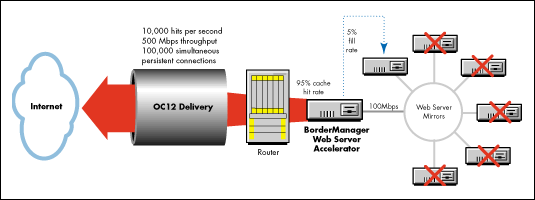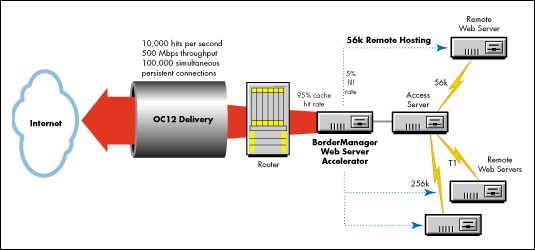BorderManager FastCache
Articles and Tips: article
01 Nov 1998
The Power of Novell Web Server Acceleration

10,000 hits per second. 500 Mbps throughput. 100,000 simultaneous connections. Traditional Web servers can't produce these kinds of results. They're overburdened and underpowered. But when you place a Novell BorderManager FastCache Web server accelerator in front of a traditional Web server, you get this screaming level of performance and incredible number of connections at a fraction of the cost of additional Web servers.
How Web Server Acceleration Works
The key to Web server acceleration lies in the fact that over 95% of the objects requested from a Web site are static objects such as HTML pages and graphics. The remainder of requests are for non-cacheable objects, such as output from CGI bin programs. It's an ideal scenario for turbo-charged caching technology.
To implement this caching technology, you configure a PC server running BorderManager FastCache to act as the front end to one or more Web servers. This "proxy caching" server pretends to be the Web server, and browsers connect to it instead of directly to the Web server. The bulk of the Web service workload is thus offloaded to the cache. The FastCache server stores the most frequently requested Web objects in RAM, enabling it to respond extremely quickly. Non-cacheable requests are passed through to the Web server, most of the time as fast or faster than if the browser was directly connected.
Another performance enhancement that BorderManager FastCache provides is the ability to maintain persistent connections. Other Web servers actively tear down persistent connections because they strain the server's resources. Since BorderManager's Web server acceleration easily supports over 100,000 simultaneous persistent connections, it maintains persistent state with your customers and it eliminates the extra Internet traffic involved in constantly tearing down and reinstating connections.
A single Novell BorderManager FastCache server has the capacity to front-end dozens of Web servers. It automatically load balances between multiple Web servers that contain the same content. It also has a clustering option that provides load balancing and fault failover between multiple FastCache servers. (See the document entitled "BorderManager Proxy Cache Clustering: A Low-Cost Solution for High-Availability ISP Services".)
This use of proxy caching to provide Web server acceleration seems like an obvious solution for boosting the power of Web servers. Yet up until now, proxy servers were slower than Web servers, so the only alternative that made sense was to add another Web server to absorb some of the workload. But now Novell has leveraged its file caching expertise to create the world's fastest Web server acceleration technology in BorderManager FastCache. For the first time, this proxy caching solution is practical for ISPs and Webmasters who want to scale services without prohibitive costs.
A Service You Can Sell
Figure 1: BorderManager FastCache eliminates the overhead and administrative hassle of mirroring multiple Web servers to increase a Web site's capacity.

As the ISP industry gets more and more competitive, it is vital that you provide the utmost in performance, scalability, and reliability. But you must also offer services that will set you apart from the others. BorderManager Web server acceleration is a great value-added service that you can offer either as a new hosting service, or as a way to accelerate your existing "co-located" Web sites (the customer Web servers that you host and manage at your site). In that way, you get all the revenue from hosting without the typical Web server management head aches that stem from co-location and Web server mirroring.
Figure 1 on the previous page illustrates how BorderManager Web server acceleration can provide a new level of performance for a Web site. By placing BorderManager FastCache software in front of the Web server, the load on the Web server processor drops dramatically and performance is greatly enhanced. Thus a single Web server accelerator can replace several Web servers that were previously required to improve performance.
This ability to accelerate a Web site can also be extended to Web servers at customers' sites. With FastCache, ISPs can sell Web server acceleration services that cache slow remote customer Web servers on the ISP's high-speed OC12 backbone. Even those Web servers connected via 56Kbps lines can realize OC12 throughput rates, thanks to the superior caching provided by BorderManager FastCache.
A BorderManager Web server accelerator is a lot easier to manage and much less expensive than Web server mirroring or arrays, which is the alternative if you or your customers want to enhance performance without Web server acceleration (see Figure 2).
Performance Leadership You Can Rely On
Figure 2: By using Web server acceleration for remotely hosted Web servers, you can provide OC12 speeds to their Internet users even if the remote servers are connected via slow links.

BorderManager FastCache relies heavily on the efficiencies of the NetWare 5 operating system platform. NetWare's architecture provides optimized support for services structured as asynchronous state machines, including minimal context switching and scheduling, and kernel-level support for anonymous threads. NetWare's high-performance protocol stacks and file system also make significant contributions to system performance.
These operating system efficiencies make NetWare the optimal platform for special-purpose network services such as BorderManager's Internet object cache. WebBench 2.0 results of over 10,000 operations per second on a single processor demonstrate Novell's leadership and continuing commitment to high-performance network services on low-cost commodity servers.
Benefits to ISPs
The benefits of BorderManager FastCache acting as a Web server accelerator are many:
The proxy server can offload up to 95% of Internet traffic from the Web server, reducing the Web server's workload and increasing Web server performance by an order of magnitude.
Since FastCache runs on low-cost commodity servers, it's a far less expensive solution than adding another Web server.
BorderManager's Web server acceleration dramatically reduces the size and number of Web servers required to host Web sites, providing unmatched scalability.
With FastCache supporting 10,000 hits per second and 100,000 simultaneous users, you have the potential to accelerate dozens of Web servers with a single BorderManager proxy server.
Conclusion
Web server acceleration is a primary component of Novell's BorderManager FastCache product which is available now. Don't miss out on this opportunity to rise above the ISP crowd by offering unbeatable Web server acceleration services to your customers. This is one product that no ISP can afford to be without.
For more information, visit Novell's BorderManager Web site at
http://www.novell.com/products/bordermanager/
Ron Lee
* Originally published in Novell AppNotes
Disclaimer
The origin of this information may be internal or external to Novell. While Novell makes all reasonable efforts to verify this information, Novell does not make explicit or implied claims to its validity.